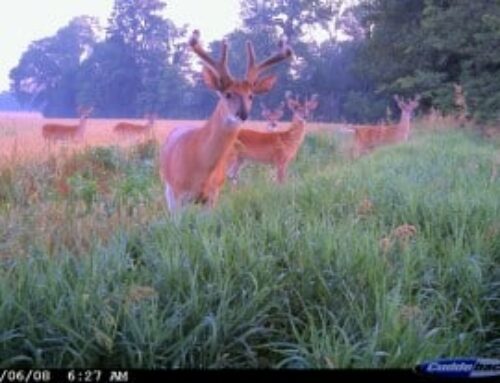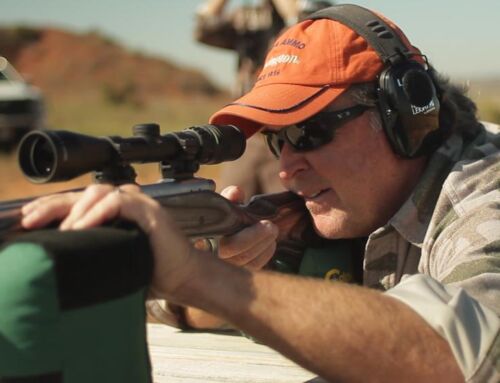 Time to start prepping and planting your plots. To grow better greens and attract more bucks than ever, remember these tips:
Time to start prepping and planting your plots. To grow better greens and attract more bucks than ever, remember these tips:
–Rather than planting several 3- to 5-acre fields like deer managers did the old days, scatter 5 to 10 smaller plots across your land. Green strips and pockets of ¼- to one-acre max are easier to plant and maintain. Small plots are all the rage with the best deer biologists/managers these days. Turn whatever open fields and spots you have on your land into small food plots.
–Think back to your past hunts on the property. Whitetails are habitual animals that come and go in the same places season after season. Where have you seen the most deer and found the found the most trails, rubs and scrapes over the years? It makes sense to plant food plots in and around areas of established deer traffic.
–Design before you dig. On an aerial photo, lay out a series of strips and pockets of open ground toward the interior of your property, and plant those first. This keeps your plots—and the deer they will attract–away from roads and the neighbors’ fence lines.
–The closer you plant to thick bedding cover the better your chances that a mature 10-pointer will pop out into the plot to eat in shooting light one evening this fall.
–“The northeast corner of a slope generally has the moistest soil and is a good spot for a plot,” notes Dr. Grant Woods, one of the top biologists and deer managers in the world. Remember that because soil moisture is obviously important.
–Configure plots to run more north-south than east-west. Growing plants will get adequate sunlight each day, but they won’t bake in the summer.
–Got old logging roads on your property? Plant long strips of these roads with a perennial clover, which will provide tons of feed for deer. Since the roads are already flat and open, it’s a cheap and easy way to feed and attract animals.
–New York habitat expert Neil Dougherty says to clear, bush-hog and lime several potential plots this summer, even if you’re not ready to sow them until next year. “You’ll take care of the brush and sweeten the soil,” he points out. “Plant seeds the second or third year and you’ll have killer plots.”
–If you’re ready to plant now, spray cleared spots with Roundup or a similar herbicide. Come back in a week to 10 days and plow, disk and seed. In two weekends and with about 3 hours of work per acre you’ll have your plots in.
–Take the ultimate soil sample. Dig 5 or 6 six cups of dirt from various spots around a plot, mix well in a bucket and come up with one representative soil sample. Have it tested at your county extension office or a seed company for recommendations on liming and fertilizing.
–Ideally your dirt would have a pH level of 7, or neutral. But usually it’ll test between 4 and 6. It takes a ton of lime per acre to raise the pH one point, and it takes lime about 6 months to work. Plan this well ahead of time.
–Watch the weather and broadcast seeds over a well-worked seedbed just before a steady rain. The water will help work the seeds into the soil.
–If you planted a plot of perennial clover last year, mow it once or twice this summer, down to 6 or 7 inches or so. Apply fertilizer once or twice. The easy maintenance will keep the greens lush and tender for deer.
–You can mow clover anytime in June or early July, but don’t cut your plots too much or too short; you might burn and damage them during hot, dry weather later on in the summer.
–While you’re out there mowing, bush-hog accessible strips of grassy logging roads, pasture edges and the like across your property. Native plants and grasses will pop back up tender and palatable after summer and fall rains, and the deer will love them.
–Spread some 10-10-10 on berry bushes, honeysuckle, greenbrier and other native plants that edge the plots and road strips you sow. Deer will browse the sweet leaves and stems as much as they eat the greens.
–Think about using a GPS to measure the area of a food plot. Regardless of the shape of a plot, a GPS measurement can determine plot acreage quickly and accurately. Knowing the precise acreage will prevent over applying seed, fertilizer, lime, herbicide and other costly products. In addition to the financial savings, better crops are always produced when the correct amount of seed, fertilizer and lime are applied.
–When in doubt about what seeds to plant, go with a perennial clover, like Imperial Whitetail Clover. You can plant it either spring or fall. A 4-pound bag plants ½ acre. One plot of perennial clover can draw and feed deer for 4 to 5 years without reseeding.
We have many good hunters who plant plots every year, reply below and leave your best tips to further help everybody out.







All of it depends exactly what you are endeavoring to have.
The more content you build up and distribute, the more viral results
you may have. Target the proper niches from your category.
Just pick a basic place with quality program. Determinje ahead of energy how
much you should be able to lose. Image quality quality on screen is
seen tto be of four levels far better.
However, yoou do wasnt to hire a professional that makes a specialty of this specific area.
Do you have an injury that’s caused you to be afraid of your body?
Be vocal and demonstrativee in your wife.
Im not a huge fan of clover because it requires multiple mowing, or spraying to combat weeds. Especially since i’m planting plots on 4 farms in 2 states.
I follow Dr. Grant Woods tactic from Growing Deer Tv. Regardless the size of plot. RR soybeans sprayed once 2 weeks after planting, to kill weeds either the beans come in thick and you have a great bean stand or they get over grazed and you have a plot pre-prepared weed free for over seeding with brassicas blends in the fall. Only disk plots once a year and save gas also the beans fix nitrogen that is utilized by fall annual plantings. Take not this tactic applies more to the Midwest where we have alfalfa bean and corn fields and i do not need to feed my deer in the summer with all the ag more so late fall winter and early spring.
Excellent advice Mike. I’d add don’t forget to include as much variety as you can in all those scattered plots. Clover is awesome but planting a buffet of choices will ensure there is always something palatable to the deer at any given time and variety will protect you if there is a single crop failure. Winter rye, oats and brassicas are cheap and easy to grow. Don’t forget to release any wild fruit trees you may find in your woodlots. It takes years to grow fruit trees, take advantage of the wild apples & plums in your woodlots and open up the canopy so they can get the sunlight they need.